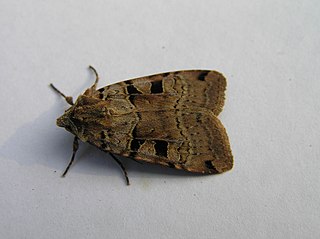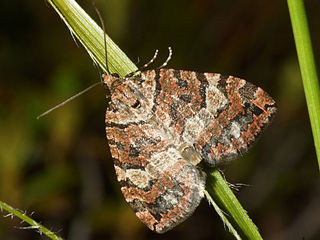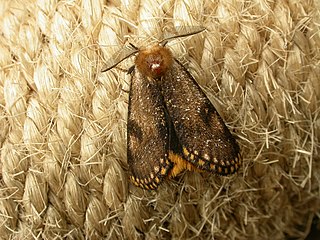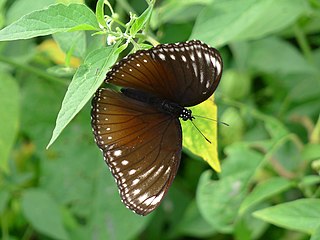
The double square-spot is a moth of the family Noctuidae. It is distributed through most of Europe except Portugal, the Mediterranean islands and northernmost Fennoscandia. In the East, the species ranges East across the Palearctic to Siberia and in the South-East to the Black Sea and in Iran. It rises to a height of about 2,000 metres (6,600 ft) in the Alps.

Cerapteryx graminis, the antler moth, is a moth of the family Noctuidae. It is a common species throughout most of Europe but is lacking in the very dry southern regions. The northernmost occurrence is Iceland, and above the Arctic circle. It also occurs in Siberia and in North Mongolia. The species has been introduced to North America. In the Alps it rises to an altitude of 2100 meters.

Hydriomena furcata, the July highflyer, is a moth of the family Geometridae. The species was first described by Carl Peter Thunberg in 1784. It is found in the Holarctic ecozone.

Epicoma contristis, the yellow-spotted epicoma, is a moth of the family Notodontidae first described by Jacob Hübner in 1823. It is known from Australia, including Tasmania, New South Wales and Victoria.

Epitymbia alaudana is a species of moth of the family Tortricidae. It is found in Australia.

Athetis maculatra is a species of moth of the family Noctuidae. It is found in Australia.

Hypolimnas anomala, commonly known as the Malayan eggfly or crow eggfly, is a species of eggfly.
Sympycnodes is a genus of moths in the family Cossidae.
Zyganisus cadigalorum is a moth in the family Cossidae. It is found in Australia, where it has been recorded from the Sydney area.
Sympycnodes tripartita is a species of moth of the family Cossidae. It is found in Australia, where it has been recorded from northern New South Wales to southern Queensland where it occurs at altitudes up to 1,000 meters.
Sympycnodes rhaptodes is a species of moth of the family Cossidae. It is found in Australia, where it has been recorded from Victoria to Queensland and possibly the Northern Territory. It is found in a wide range of habitats, including subalpine areas, as well as wet and dry sclerophyll forests.

Sympycnodes epicycla is a species of moth in the family Cossidae. It is found in Australia, where it is widely distributed in the eastern part of the continent. The habitat consists of dry to wet sclerophyll forests and woodland.
Sympycnodes arachnophora is a species of moth of the family Cossidae. It is found in Australia, where it is only found in inland south-eastern Australia. The habitat consists of dry woodland.
Sympycnodes digitata is a species of moth of the family Cossidae. It is found in Australia, where it has been recorded along the eastern coast and tablelands from the Queensland to Victoria. The habitat consists of wet sclerophyll forests.
Sympycnodes dunnorum is a species of moth of the family Cossidae. It is found in Australia, where it has been recorded from Western Australia, through South Australia to Victoria, the Australian Capital Territory, New South Wales and Queensland. The habitat consists of coastal woodland and dry forests.
Sympycnodes salterra is a species of moth of the family Cossidae. It is found in Australia, where it has been recorded from northern New South Wales, Queensland and Western Australia. The habitat consists of dry woodland.
Sympycnodes uptoni is a species of moth of the family Cossidae. It is found in Australia, where it has been recorded from northern Western Australia.
Sympycnodes adrienneae is a species of moth of the family Cossidae. It is found in Australia, where it has been recorded from the dry inland mallee of Victoria and New South Wales.
Bactra blepharopis is a species of moth of the family Tortricidae. It is found in New Caledonia and Australia, where it has been recorded from New South Wales and Queensland.







